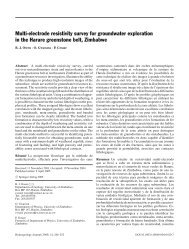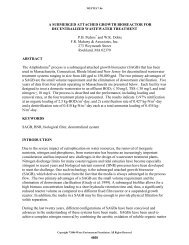an assessment of environmental concerns in the leather industry
an assessment of environmental concerns in the leather industry
an assessment of environmental concerns in the leather industry
You also want an ePaper? Increase the reach of your titles
YUMPU automatically turns print PDFs into web optimized ePapers that Google loves.
content. The Chrome t<strong>an</strong>ned waste conta<strong>in</strong>s Chromium <strong>in</strong> trivalent form but it was found that when <strong>the</strong><br />
solid wastes are used <strong>in</strong> mak<strong>in</strong>g poultry feed <strong>the</strong> Chromium is converted to hexavalent form which is<br />
carc<strong>in</strong>ogenic. The mix<strong>in</strong>g <strong>of</strong> this metal <strong>in</strong> poultry feed could produce serious hum<strong>an</strong> health problems. It is<br />
estimated that for a t<strong>an</strong>nery produc<strong>in</strong>g on <strong>an</strong> average 10,000 kilograms <strong>of</strong> sk<strong>in</strong>s per day, a total <strong>of</strong> about<br />
5,500 kilograms <strong>of</strong> solid waste would be produced per day. Table 2 presents a breakdown on this waste<br />
<strong>an</strong>d its key characteristics with comments.<br />
Type <strong>of</strong><br />
Solid Waste<br />
Rate <strong>of</strong><br />
Generation<br />
Characteristics <strong>of</strong> Solid Waste<br />
Dusted Salt 0.1 kg/sk<strong>in</strong> Conta<strong>in</strong>s around 120 gm/kg <strong>of</strong><br />
moisture, 120 gm/kg <strong>of</strong> volatile<br />
matter, 450 gm/kg <strong>of</strong> salt.<br />
Raw<br />
Trimm<strong>in</strong>gs<br />
Table 2: Solid Waste <strong>in</strong> T<strong>an</strong>neries<br />
Comments<br />
Contam<strong>in</strong>ated with blood, hair, dirt <strong>an</strong>d bacteria. Partly<br />
reused <strong>in</strong> cur<strong>in</strong>g <strong>an</strong>d <strong>the</strong> rest is <strong>in</strong>discrim<strong>in</strong>ately dumped <strong>in</strong><br />
undeveloped l<strong>an</strong>ds near <strong>the</strong> t<strong>an</strong>neries.<br />
0.024 kg/sk<strong>in</strong> Prote<strong>in</strong>s The sk<strong>in</strong>s are trimmed (especially at legs, belly, neck, <strong>an</strong>d<br />
tail parts) <strong>in</strong> order to give <strong>the</strong>m a smooth shape. The<br />
trimm<strong>in</strong>gs are usually sold to soap <strong>an</strong>d poultry feed<br />
production<br />
Flesh<strong>in</strong>g 0.25 kg/sk<strong>in</strong> Conta<strong>in</strong>s around 240 gm/kg <strong>of</strong><br />
prote<strong>in</strong>s, 200 gm/kg <strong>of</strong> fats, 3 gm/kg<br />
<strong>of</strong> sulphide.<br />
Wet<br />
Trimm<strong>in</strong>g/<br />
Wet<br />
shav<strong>in</strong>g<br />
Dry<br />
Trimm<strong>in</strong>gs/<br />
Dry<br />
Shav<strong>in</strong>g/Bu<br />
ff<strong>in</strong>g Dust<br />
Assorted<br />
Refuse<br />
Source: ETPI Survey<br />
0.14 kg/sk<strong>in</strong> Conta<strong>in</strong>s around 240 gm/kg <strong>of</strong><br />
prote<strong>in</strong>s, 30 gm/kg <strong>of</strong> fats, 15 gm/kg<br />
<strong>of</strong> chromium oxide<br />
0.06 kg/sk<strong>in</strong> Conta<strong>in</strong>s around 300 gm/kg <strong>of</strong><br />
prote<strong>in</strong>s, 130 gm/kg <strong>of</strong> fats, 30<br />
gm/kg <strong>of</strong> chromium oxide<br />
No consistent<br />
qu<strong>an</strong>tity<br />
Primarily cartons, bags, drums, etc.<br />
This is <strong>the</strong> flesh material <strong>of</strong> limed sk<strong>in</strong>s. It is usually sold<br />
to soap <strong>an</strong>d poultry feed makers.<br />
After chrome t<strong>an</strong>n<strong>in</strong>g, sk<strong>in</strong>s or split hides are shaved to<br />
proper thickness. This operation produces solid waste<br />
conta<strong>in</strong><strong>in</strong>g chrome. Secondary users <strong>in</strong>clud<strong>in</strong>g poultry<br />
feed makers, usually collect <strong>the</strong>se shav<strong>in</strong>g from <strong>the</strong><br />
t<strong>an</strong>ners.<br />
Secondary users, <strong>in</strong>clud<strong>in</strong>g poultry feed makers, collect<br />
cutt<strong>in</strong>gs <strong>an</strong>d dry trimm<strong>in</strong>gs <strong>an</strong>d buff<strong>in</strong>g dust <strong>of</strong> <strong>the</strong> lea<strong>the</strong>r<br />
from <strong>the</strong> t<strong>an</strong>neries.<br />
This is normally sold separately (<strong>in</strong> bulk) <strong>in</strong> <strong>the</strong> retail<br />
market.<br />
Air Emissions<br />
In t<strong>an</strong>neries air emissions are produced from <strong>the</strong> stacks <strong>of</strong> boilers <strong>an</strong>d generators <strong>an</strong>d dur<strong>in</strong>g <strong>the</strong> process<strong>in</strong>g<br />
<strong>of</strong> lea<strong>the</strong>r. Emissions from <strong>the</strong> stacks are well with<strong>in</strong> <strong>the</strong> limits <strong>an</strong>d pose no serious <strong>environmental</strong> impact.<br />
But hydrogen Sulphide <strong>an</strong>d ammonia gases which are emitted dur<strong>in</strong>g different processes are a health<br />
hazard for <strong>the</strong> workers.<br />
ENVIRONMENTAL IMPACTS OF POLLUTANTS<br />
Out <strong>of</strong> <strong>the</strong> three wastes mentioned, air emissions are very low as compared to <strong>the</strong> st<strong>an</strong>dards mentioned <strong>in</strong><br />
NEQS whereas <strong>the</strong> solid wastes are used <strong>in</strong> preparation <strong>of</strong> poultry feed which pose health problems. The<br />
wastewater is a serious threat to <strong>the</strong> environment. T<strong>an</strong>neries are dispos<strong>in</strong>g <strong>of</strong> <strong>the</strong>ir wastewater <strong>in</strong>to dra<strong>in</strong>s,<br />
which f<strong>in</strong>ally f<strong>in</strong>d its way <strong>in</strong>to natural water bodies. Therefore major <strong>environmental</strong> problems are l<strong>in</strong>ked<br />
with <strong>the</strong> wastewater <strong>of</strong> t<strong>an</strong>neries.<br />
The pH <strong>of</strong> directly discharged t<strong>an</strong>nery effluent varies between 3.5 to 13.5. Water with a low pH is<br />
corrosive to water-carry<strong>in</strong>g systems <strong>an</strong>d c<strong>an</strong> lead to metal dissolv<strong>in</strong>g <strong>in</strong> <strong>the</strong> water. The high pH water c<strong>an</strong><br />
cause scal<strong>in</strong>g <strong>in</strong> <strong>the</strong> sewers. Also large fluctuation <strong>in</strong> <strong>the</strong> pH value is detrimental to some aquatic species.<br />
The large qu<strong>an</strong>tities <strong>of</strong> prote<strong>in</strong>s <strong>an</strong>d <strong>the</strong>ir degrad<strong>in</strong>g products form<strong>in</strong>g a major part <strong>of</strong> <strong>the</strong> wastewater c<strong>an</strong>
















